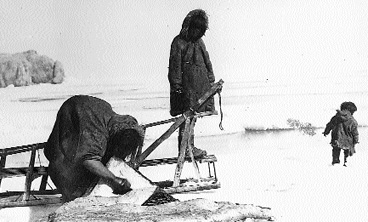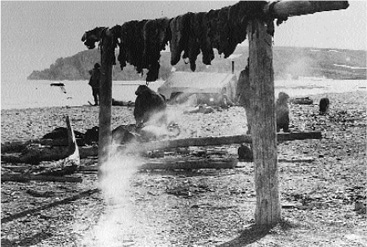The Ice Master (57 page)
Authors: Jennifer Niven

The last photograph of the
Karluk
before she went down. The ice blocks surrounding the hull were cut from the ice pack in an effort to insulate the ship from the bitter cold of the Arctic winter.
Â
Â
Â

Shipwreck Camp.
Â
Â
Â

“To look at the ice, one would think it impossible ever to get through it. In some parts there are ridges of 60 or 70 ft. in height, some even higher, with a sheer vertical face on one side as smooth as if they had been built by human hands. And we must get over & through & we must camp here until we have made that passable.” William McKinlay, March 1914.
Â
Â
Â

“Wrangel Island is eighty-five miles long, and varies from twenty-eight to thirty-five miles in width, and is practically all mountainous. It lies one hundred miles off the coast of Siberia and is the most desolate-looking place I have ever seen, or ever wish to see again.” Ernest Chafe, March 1914.
Â
Â
Â

Kataktovik on Wrangel Island shortly before he and Captain Bartlett set out on their extraordinary 700-mile journey across the ice to Siberia to get help. Apart from Helen and Mugpi, Kataktovik was, at nineteen, the youngest member of the expedition.
Â
Â
Â

Auntie with Helen and Mugpi on Wrangel Island, skinning a seal. The Eskimos were the hunters and were responsible for finding at least 80 percent of the game on the island.
Â
Â
Â

Nigeraurak, the ship's cat and good luck mascot. Little Mugpi used to tease the kitten and was rewarded with a deep scratch, which left a distinct scar.
Â
Â
Â

Mugpi, now four years old, with one of the ship's dogs.
Â
Â
Â

From left to right, Ernest Chafe, John Hadley, Robert Williamson, Kuraluk, Mugpi, and Helen butchering a walrus. Chafe is holding the animal's flippers.
Â
Â
Â

The meat rack. After butchering game, the meat would be left to dry in the sun to preserve it for winter supplies.
Â
Â
Â

John Hadley, a trapper who had joined the
Karluk
to escape his grief following the death of his Eskimo wife. He is shown here with his faithful dog, Molly.
Â
Â
Â

William McKinlay, Robert Williamson, George Breddy, Ernest Chafe, and “Clam” Williams. A rare photograph of scientists and crew together. The divisions between them, already noticeable onboard ship, became even more marked on the island. The camp would ultimately split in two, with McKinlay joining the Eskimos' tent.
Â
Â
Â
